Economic Evaluation Report: Analysis in Healthcare Setting
VerifiedAdded on 2021/06/15
|13
|2907
|26
Report
AI Summary
This report provides a comprehensive overview of economic evaluation within the healthcare sector. It begins by emphasizing the significance of economic evaluation in optimizing the use of limited resources and enhancing decision-making processes. The report delves into the various types of economic evaluation, including cost-minimization, cost-utility, cost-benefit, and cost-effectiveness analyses, detailing their features and applications. It presents a study question focused on a new intervention, 'Sleeping Well,' and outlines the study design, emphasizing a cost-utility analysis perspective. The report further discusses the categorization of costs, data collection methods, resource valuation, and the measurement of health outcomes. Finally, it underscores the role of economic evaluation in improving healthcare management, planning, and intervention selection, ensuring that chosen interventions effectively address patient needs and contribute to overall health improvements. The report includes references to relevant literature supporting its analysis.
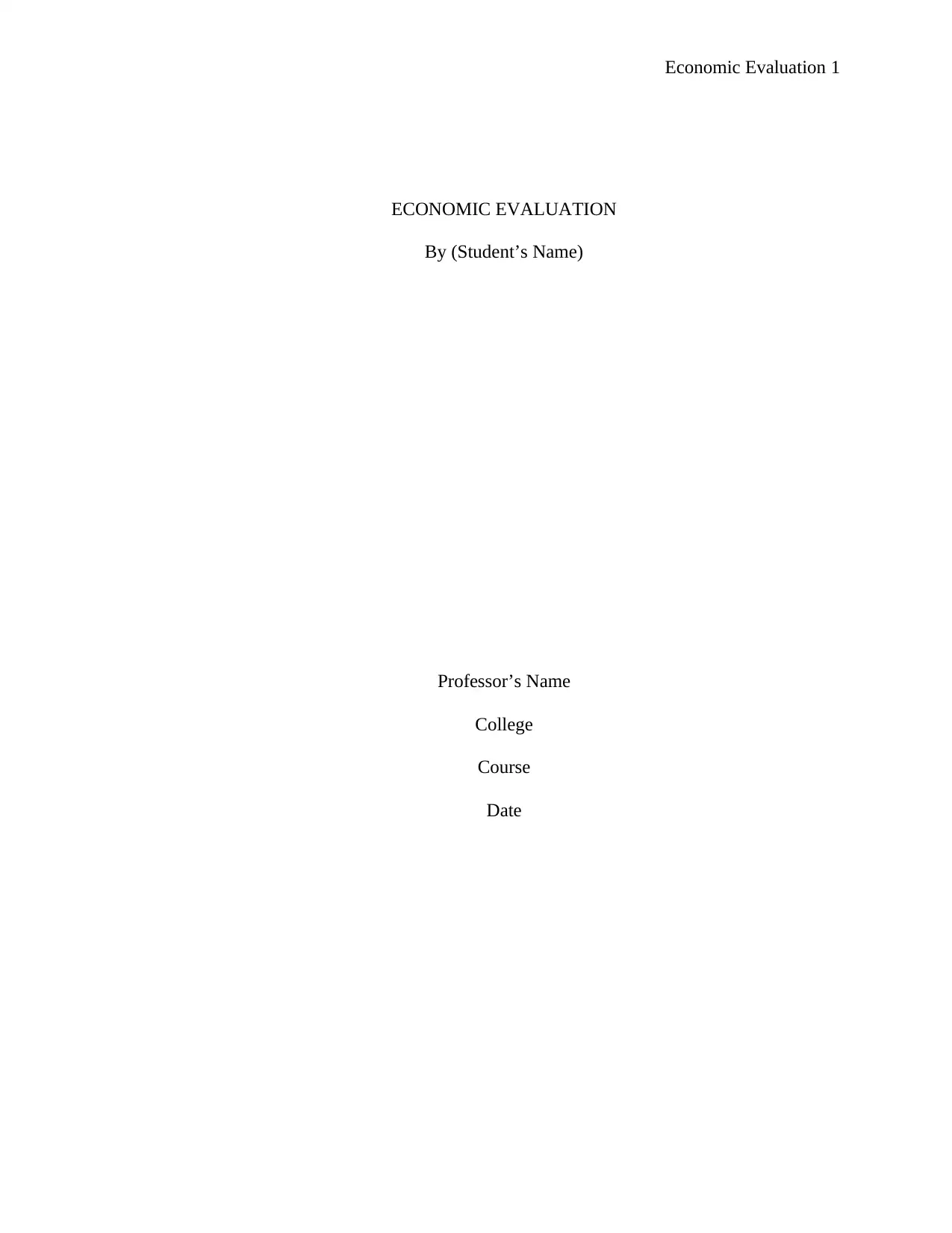
Economic Evaluation 1
ECONOMIC EVALUATION
By (Student’s Name)
Professor’s Name
College
Course
Date
ECONOMIC EVALUATION
By (Student’s Name)
Professor’s Name
College
Course
Date
Paraphrase This Document
Need a fresh take? Get an instant paraphrase of this document with our AI Paraphraser
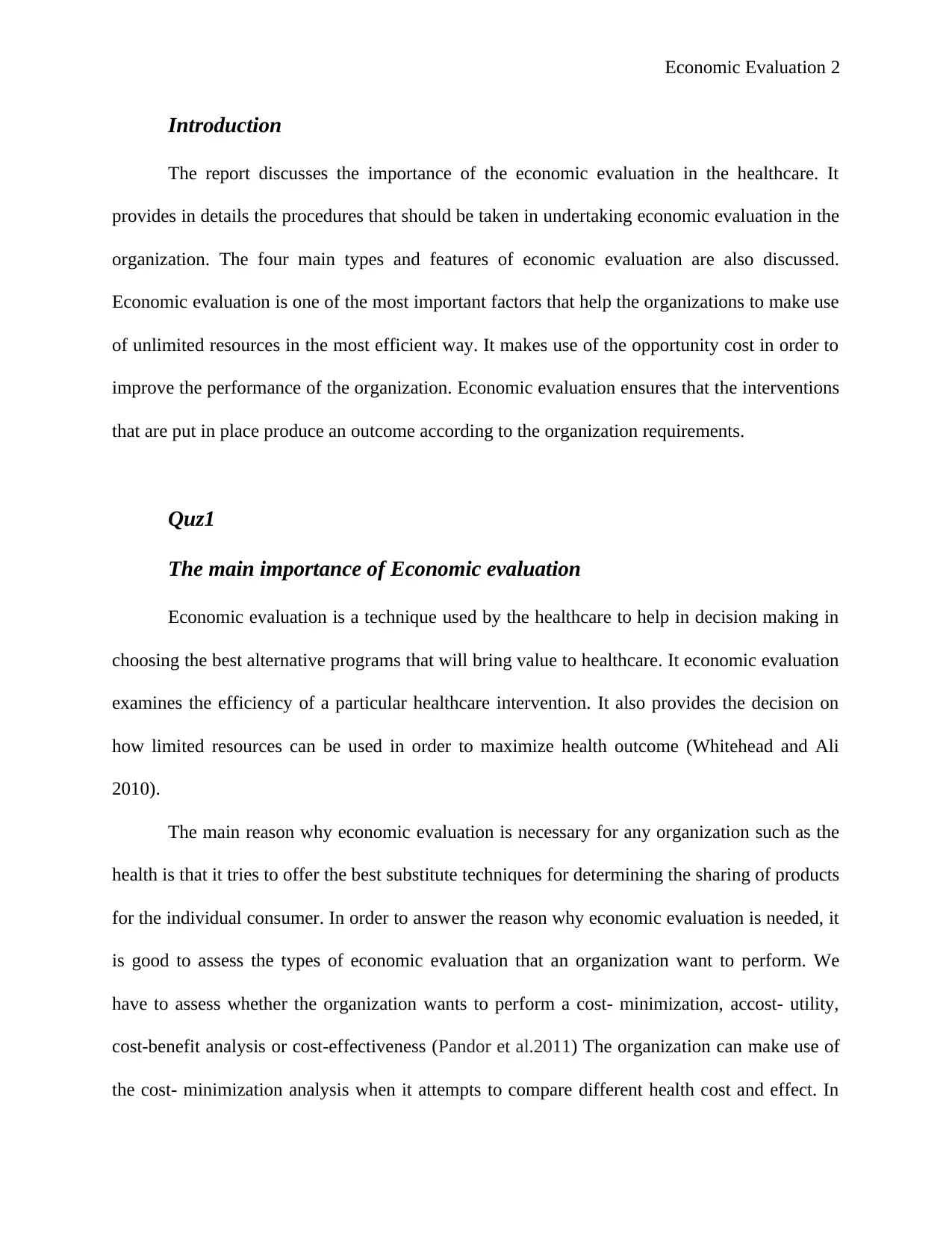
Economic Evaluation 2
Introduction
The report discusses the importance of the economic evaluation in the healthcare. It
provides in details the procedures that should be taken in undertaking economic evaluation in the
organization. The four main types and features of economic evaluation are also discussed.
Economic evaluation is one of the most important factors that help the organizations to make use
of unlimited resources in the most efficient way. It makes use of the opportunity cost in order to
improve the performance of the organization. Economic evaluation ensures that the interventions
that are put in place produce an outcome according to the organization requirements.
Quz1
The main importance of Economic evaluation
Economic evaluation is a technique used by the healthcare to help in decision making in
choosing the best alternative programs that will bring value to healthcare. It economic evaluation
examines the efficiency of a particular healthcare intervention. It also provides the decision on
how limited resources can be used in order to maximize health outcome (Whitehead and Ali
2010).
The main reason why economic evaluation is necessary for any organization such as the
health is that it tries to offer the best substitute techniques for determining the sharing of products
for the individual consumer. In order to answer the reason why economic evaluation is needed, it
is good to assess the types of economic evaluation that an organization want to perform. We
have to assess whether the organization wants to perform a cost- minimization, accost- utility,
cost-benefit analysis or cost-effectiveness (Pandor et al.2011) The organization can make use of
the cost- minimization analysis when it attempts to compare different health cost and effect. In
Introduction
The report discusses the importance of the economic evaluation in the healthcare. It
provides in details the procedures that should be taken in undertaking economic evaluation in the
organization. The four main types and features of economic evaluation are also discussed.
Economic evaluation is one of the most important factors that help the organizations to make use
of unlimited resources in the most efficient way. It makes use of the opportunity cost in order to
improve the performance of the organization. Economic evaluation ensures that the interventions
that are put in place produce an outcome according to the organization requirements.
Quz1
The main importance of Economic evaluation
Economic evaluation is a technique used by the healthcare to help in decision making in
choosing the best alternative programs that will bring value to healthcare. It economic evaluation
examines the efficiency of a particular healthcare intervention. It also provides the decision on
how limited resources can be used in order to maximize health outcome (Whitehead and Ali
2010).
The main reason why economic evaluation is necessary for any organization such as the
health is that it tries to offer the best substitute techniques for determining the sharing of products
for the individual consumer. In order to answer the reason why economic evaluation is needed, it
is good to assess the types of economic evaluation that an organization want to perform. We
have to assess whether the organization wants to perform a cost- minimization, accost- utility,
cost-benefit analysis or cost-effectiveness (Pandor et al.2011) The organization can make use of
the cost- minimization analysis when it attempts to compare different health cost and effect. In
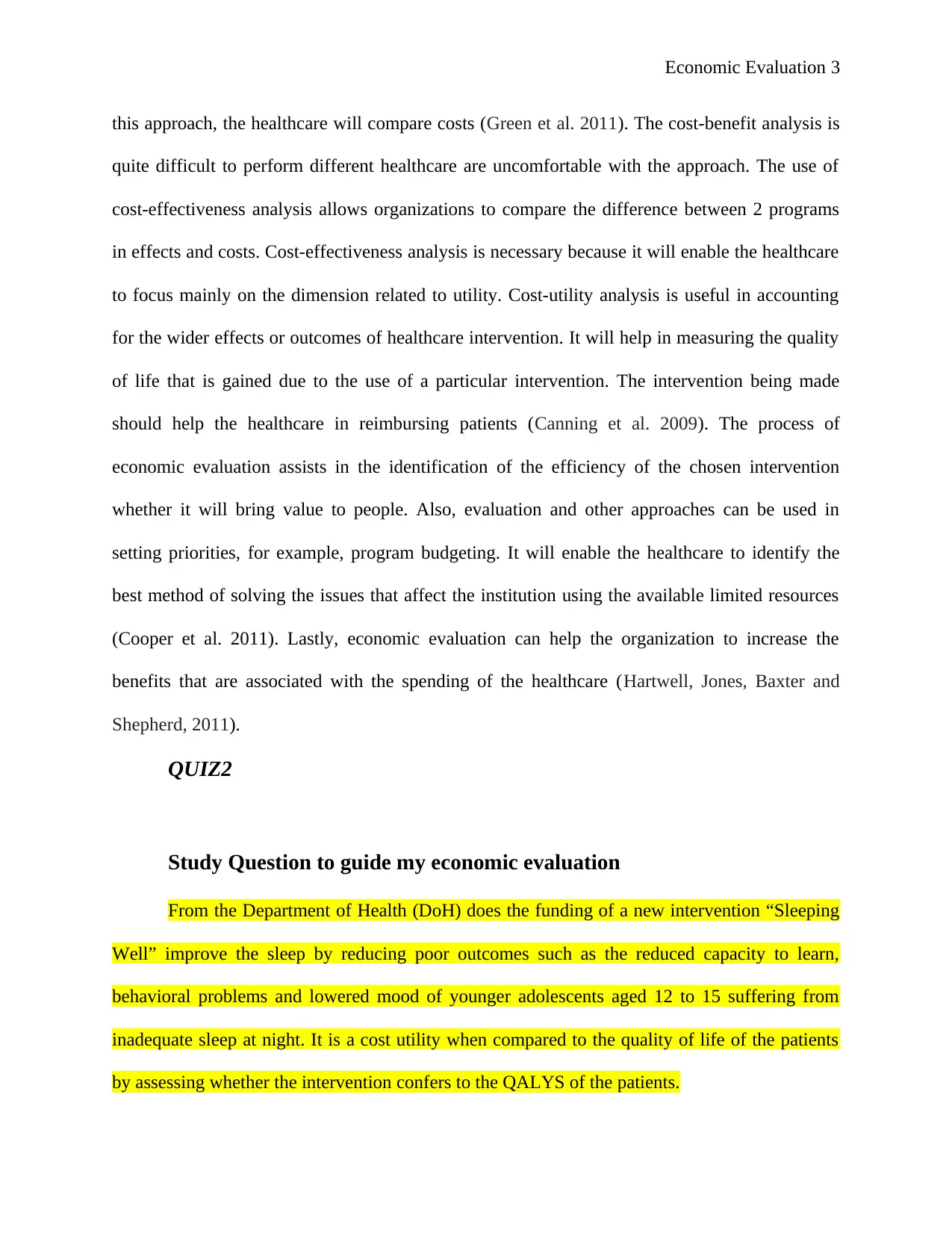
Economic Evaluation 3
this approach, the healthcare will compare costs (Green et al. 2011). The cost-benefit analysis is
quite difficult to perform different healthcare are uncomfortable with the approach. The use of
cost-effectiveness analysis allows organizations to compare the difference between 2 programs
in effects and costs. Cost-effectiveness analysis is necessary because it will enable the healthcare
to focus mainly on the dimension related to utility. Cost-utility analysis is useful in accounting
for the wider effects or outcomes of healthcare intervention. It will help in measuring the quality
of life that is gained due to the use of a particular intervention. The intervention being made
should help the healthcare in reimbursing patients (Canning et al. 2009). The process of
economic evaluation assists in the identification of the efficiency of the chosen intervention
whether it will bring value to people. Also, evaluation and other approaches can be used in
setting priorities, for example, program budgeting. It will enable the healthcare to identify the
best method of solving the issues that affect the institution using the available limited resources
(Cooper et al. 2011). Lastly, economic evaluation can help the organization to increase the
benefits that are associated with the spending of the healthcare (Hartwell, Jones, Baxter and
Shepherd, 2011).
QUIZ2
Study Question to guide my economic evaluation
From the Department of Health (DoH) does the funding of a new intervention “Sleeping
Well” improve the sleep by reducing poor outcomes such as the reduced capacity to learn,
behavioral problems and lowered mood of younger adolescents aged 12 to 15 suffering from
inadequate sleep at night. It is a cost utility when compared to the quality of life of the patients
by assessing whether the intervention confers to the QALYS of the patients.
this approach, the healthcare will compare costs (Green et al. 2011). The cost-benefit analysis is
quite difficult to perform different healthcare are uncomfortable with the approach. The use of
cost-effectiveness analysis allows organizations to compare the difference between 2 programs
in effects and costs. Cost-effectiveness analysis is necessary because it will enable the healthcare
to focus mainly on the dimension related to utility. Cost-utility analysis is useful in accounting
for the wider effects or outcomes of healthcare intervention. It will help in measuring the quality
of life that is gained due to the use of a particular intervention. The intervention being made
should help the healthcare in reimbursing patients (Canning et al. 2009). The process of
economic evaluation assists in the identification of the efficiency of the chosen intervention
whether it will bring value to people. Also, evaluation and other approaches can be used in
setting priorities, for example, program budgeting. It will enable the healthcare to identify the
best method of solving the issues that affect the institution using the available limited resources
(Cooper et al. 2011). Lastly, economic evaluation can help the organization to increase the
benefits that are associated with the spending of the healthcare (Hartwell, Jones, Baxter and
Shepherd, 2011).
QUIZ2
Study Question to guide my economic evaluation
From the Department of Health (DoH) does the funding of a new intervention “Sleeping
Well” improve the sleep by reducing poor outcomes such as the reduced capacity to learn,
behavioral problems and lowered mood of younger adolescents aged 12 to 15 suffering from
inadequate sleep at night. It is a cost utility when compared to the quality of life of the patients
by assessing whether the intervention confers to the QALYS of the patients.
⊘ This is a preview!⊘
Do you want full access?
Subscribe today to unlock all pages.

Trusted by 1+ million students worldwide
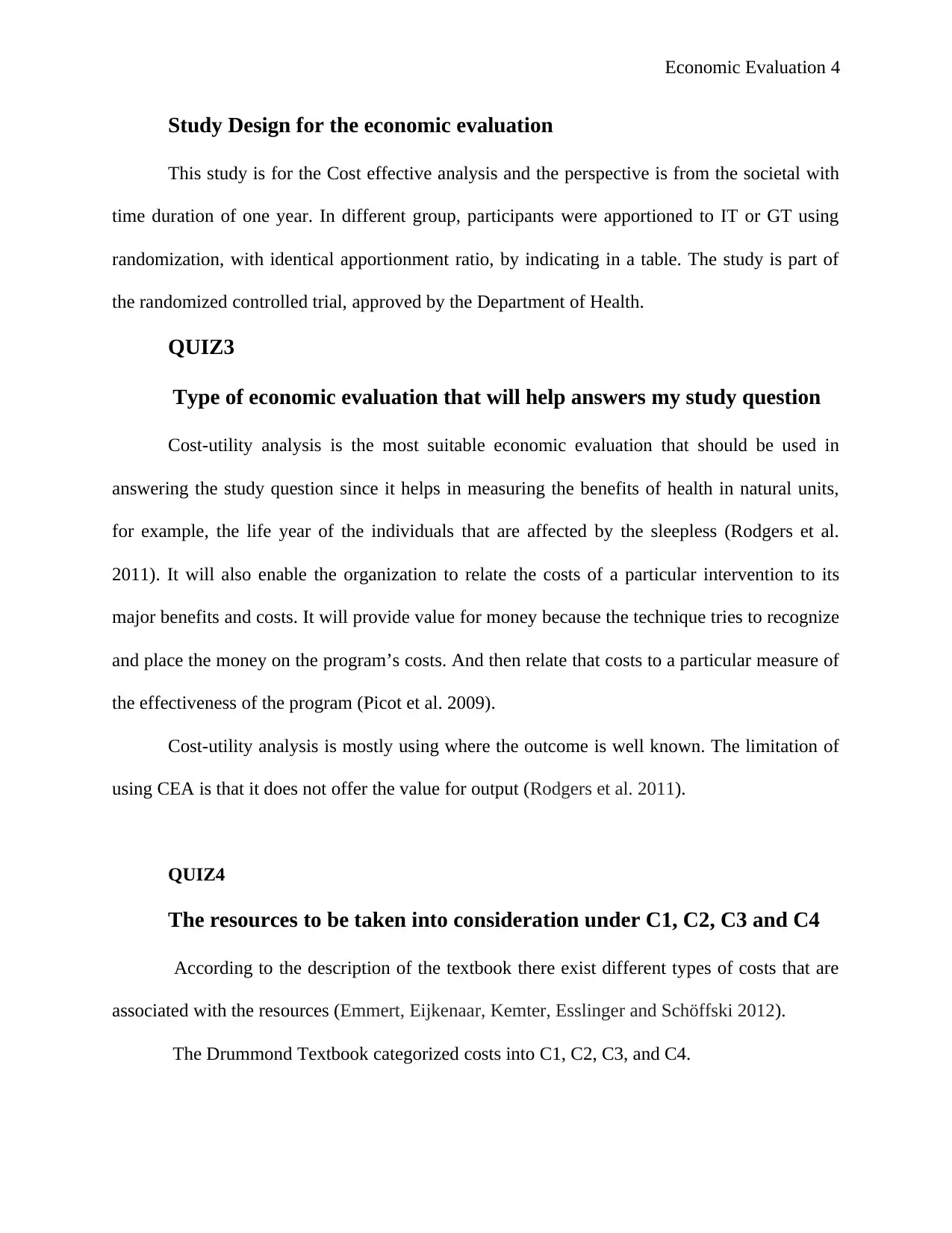
Economic Evaluation 4
Study Design for the economic evaluation
This study is for the Cost effective analysis and the perspective is from the societal with
time duration of one year. In different group, participants were apportioned to IT or GT using
randomization, with identical apportionment ratio, by indicating in a table. The study is part of
the randomized controlled trial, approved by the Department of Health.
QUIZ3
Type of economic evaluation that will help answers my study question
Cost-utility analysis is the most suitable economic evaluation that should be used in
answering the study question since it helps in measuring the benefits of health in natural units,
for example, the life year of the individuals that are affected by the sleepless (Rodgers et al.
2011). It will also enable the organization to relate the costs of a particular intervention to its
major benefits and costs. It will provide value for money because the technique tries to recognize
and place the money on the program’s costs. And then relate that costs to a particular measure of
the effectiveness of the program (Picot et al. 2009).
Cost-utility analysis is mostly using where the outcome is well known. The limitation of
using CEA is that it does not offer the value for output (Rodgers et al. 2011).
QUIZ4
The resources to be taken into consideration under C1, C2, C3 and C4
According to the description of the textbook there exist different types of costs that are
associated with the resources (Emmert, Eijkenaar, Kemter, Esslinger and Schöffski 2012).
The Drummond Textbook categorized costs into C1, C2, C3, and C4.
Study Design for the economic evaluation
This study is for the Cost effective analysis and the perspective is from the societal with
time duration of one year. In different group, participants were apportioned to IT or GT using
randomization, with identical apportionment ratio, by indicating in a table. The study is part of
the randomized controlled trial, approved by the Department of Health.
QUIZ3
Type of economic evaluation that will help answers my study question
Cost-utility analysis is the most suitable economic evaluation that should be used in
answering the study question since it helps in measuring the benefits of health in natural units,
for example, the life year of the individuals that are affected by the sleepless (Rodgers et al.
2011). It will also enable the organization to relate the costs of a particular intervention to its
major benefits and costs. It will provide value for money because the technique tries to recognize
and place the money on the program’s costs. And then relate that costs to a particular measure of
the effectiveness of the program (Picot et al. 2009).
Cost-utility analysis is mostly using where the outcome is well known. The limitation of
using CEA is that it does not offer the value for output (Rodgers et al. 2011).
QUIZ4
The resources to be taken into consideration under C1, C2, C3 and C4
According to the description of the textbook there exist different types of costs that are
associated with the resources (Emmert, Eijkenaar, Kemter, Esslinger and Schöffski 2012).
The Drummond Textbook categorized costs into C1, C2, C3, and C4.
Paraphrase This Document
Need a fresh take? Get an instant paraphrase of this document with our AI Paraphraser
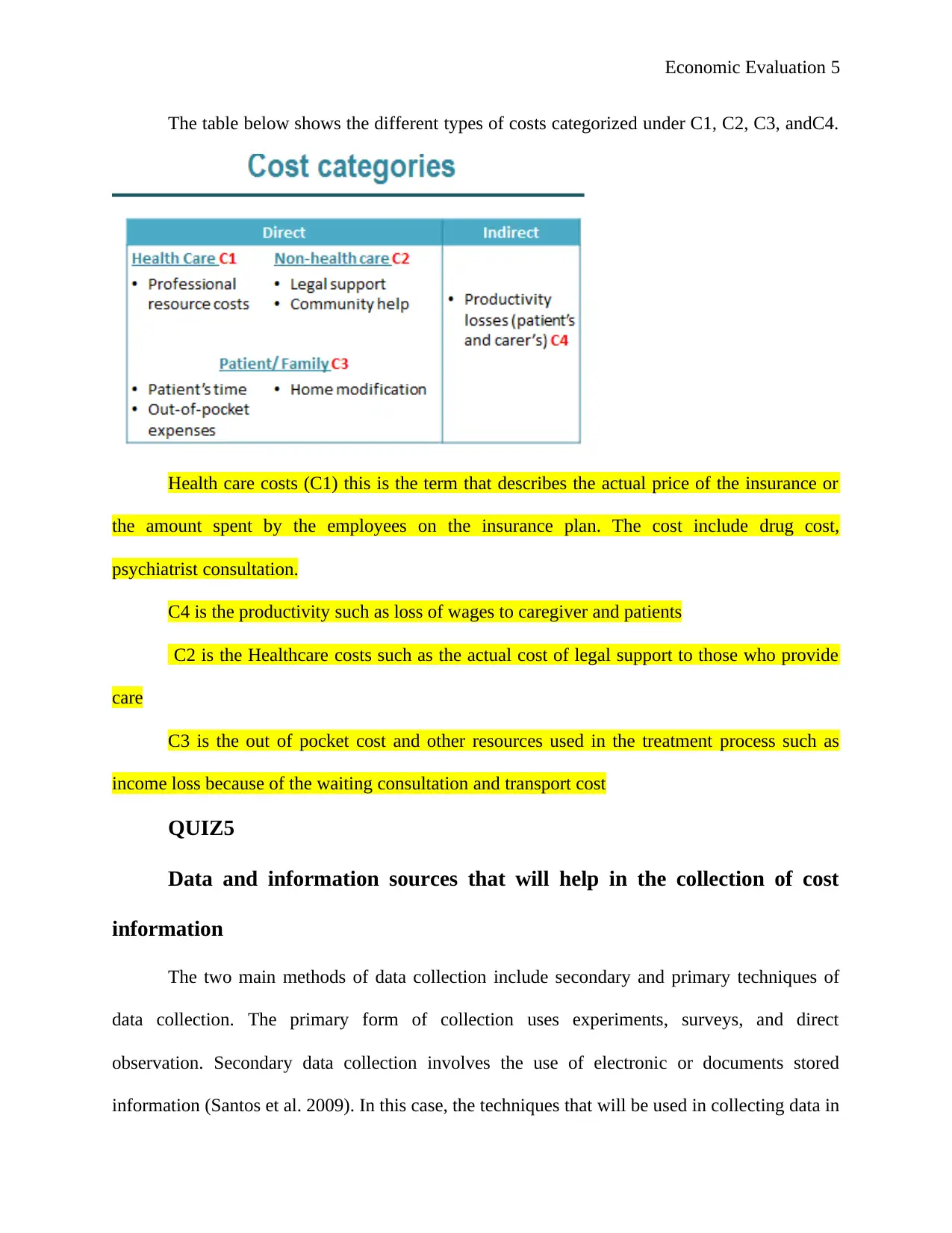
Economic Evaluation 5
The table below shows the different types of costs categorized under C1, C2, C3, andC4.
Health care costs (C1) this is the term that describes the actual price of the insurance or
the amount spent by the employees on the insurance plan. The cost include drug cost,
psychiatrist consultation.
C4 is the productivity such as loss of wages to caregiver and patients
C2 is the Healthcare costs such as the actual cost of legal support to those who provide
care
C3 is the out of pocket cost and other resources used in the treatment process such as
income loss because of the waiting consultation and transport cost
QUIZ5
Data and information sources that will help in the collection of cost
information
The two main methods of data collection include secondary and primary techniques of
data collection. The primary form of collection uses experiments, surveys, and direct
observation. Secondary data collection involves the use of electronic or documents stored
information (Santos et al. 2009). In this case, the techniques that will be used in collecting data in
The table below shows the different types of costs categorized under C1, C2, C3, andC4.
Health care costs (C1) this is the term that describes the actual price of the insurance or
the amount spent by the employees on the insurance plan. The cost include drug cost,
psychiatrist consultation.
C4 is the productivity such as loss of wages to caregiver and patients
C2 is the Healthcare costs such as the actual cost of legal support to those who provide
care
C3 is the out of pocket cost and other resources used in the treatment process such as
income loss because of the waiting consultation and transport cost
QUIZ5
Data and information sources that will help in the collection of cost
information
The two main methods of data collection include secondary and primary techniques of
data collection. The primary form of collection uses experiments, surveys, and direct
observation. Secondary data collection involves the use of electronic or documents stored
information (Santos et al. 2009). In this case, the techniques that will be used in collecting data in
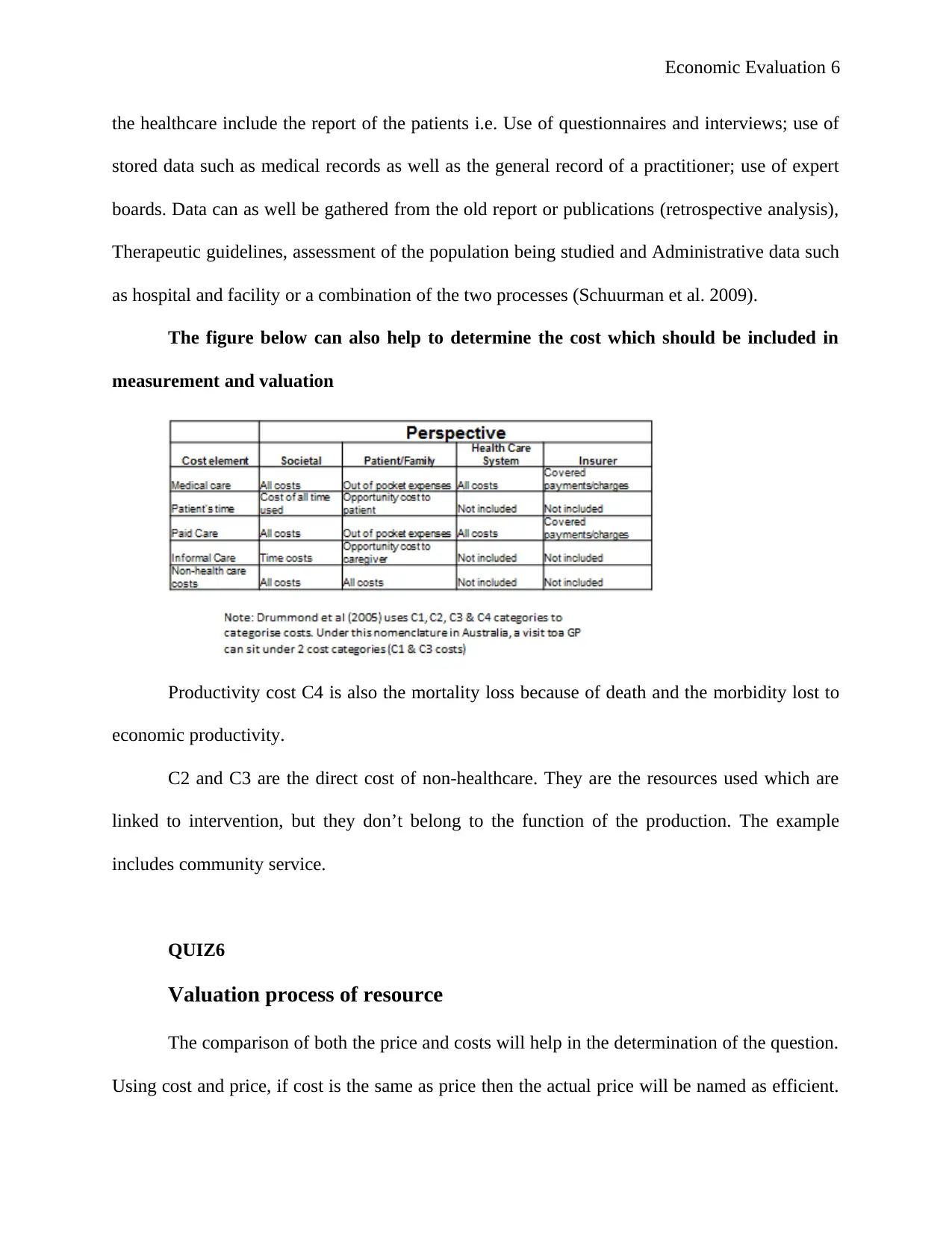
Economic Evaluation 6
the healthcare include the report of the patients i.e. Use of questionnaires and interviews; use of
stored data such as medical records as well as the general record of a practitioner; use of expert
boards. Data can as well be gathered from the old report or publications (retrospective analysis),
Therapeutic guidelines, assessment of the population being studied and Administrative data such
as hospital and facility or a combination of the two processes (Schuurman et al. 2009).
The figure below can also help to determine the cost which should be included in
measurement and valuation
Productivity cost C4 is also the mortality loss because of death and the morbidity lost to
economic productivity.
C2 and C3 are the direct cost of non-healthcare. They are the resources used which are
linked to intervention, but they don’t belong to the function of the production. The example
includes community service.
QUIZ6
Valuation process of resource
The comparison of both the price and costs will help in the determination of the question.
Using cost and price, if cost is the same as price then the actual price will be named as efficient.
the healthcare include the report of the patients i.e. Use of questionnaires and interviews; use of
stored data such as medical records as well as the general record of a practitioner; use of expert
boards. Data can as well be gathered from the old report or publications (retrospective analysis),
Therapeutic guidelines, assessment of the population being studied and Administrative data such
as hospital and facility or a combination of the two processes (Schuurman et al. 2009).
The figure below can also help to determine the cost which should be included in
measurement and valuation
Productivity cost C4 is also the mortality loss because of death and the morbidity lost to
economic productivity.
C2 and C3 are the direct cost of non-healthcare. They are the resources used which are
linked to intervention, but they don’t belong to the function of the production. The example
includes community service.
QUIZ6
Valuation process of resource
The comparison of both the price and costs will help in the determination of the question.
Using cost and price, if cost is the same as price then the actual price will be named as efficient.
⊘ This is a preview!⊘
Do you want full access?
Subscribe today to unlock all pages.

Trusted by 1+ million students worldwide
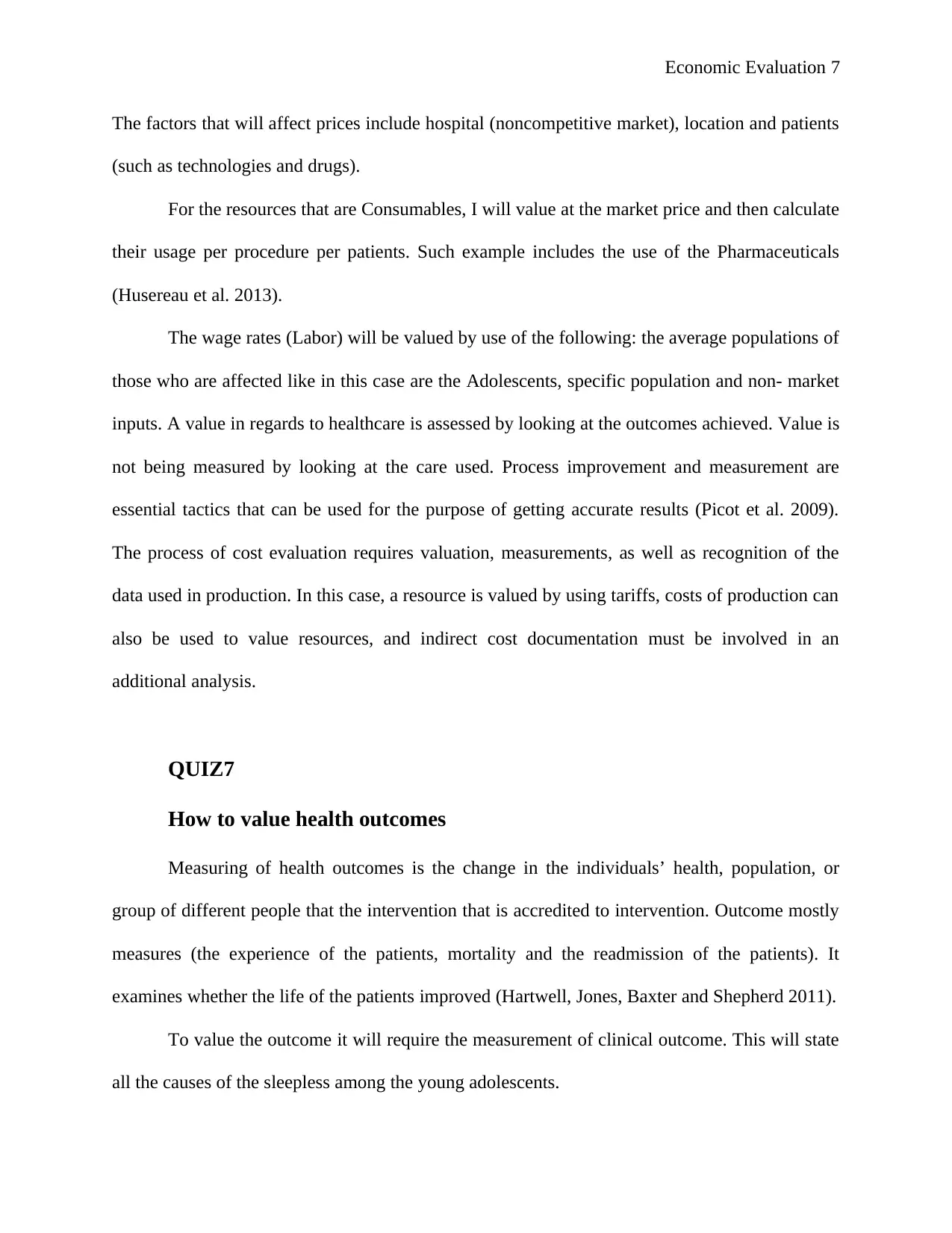
Economic Evaluation 7
The factors that will affect prices include hospital (noncompetitive market), location and patients
(such as technologies and drugs).
For the resources that are Consumables, I will value at the market price and then calculate
their usage per procedure per patients. Such example includes the use of the Pharmaceuticals
(Husereau et al. 2013).
The wage rates (Labor) will be valued by use of the following: the average populations of
those who are affected like in this case are the Adolescents, specific population and non- market
inputs. A value in regards to healthcare is assessed by looking at the outcomes achieved. Value is
not being measured by looking at the care used. Process improvement and measurement are
essential tactics that can be used for the purpose of getting accurate results (Picot et al. 2009).
The process of cost evaluation requires valuation, measurements, as well as recognition of the
data used in production. In this case, a resource is valued by using tariffs, costs of production can
also be used to value resources, and indirect cost documentation must be involved in an
additional analysis.
QUIZ7
How to value health outcomes
Measuring of health outcomes is the change in the individuals’ health, population, or
group of different people that the intervention that is accredited to intervention. Outcome mostly
measures (the experience of the patients, mortality and the readmission of the patients). It
examines whether the life of the patients improved (Hartwell, Jones, Baxter and Shepherd 2011).
To value the outcome it will require the measurement of clinical outcome. This will state
all the causes of the sleepless among the young adolescents.
The factors that will affect prices include hospital (noncompetitive market), location and patients
(such as technologies and drugs).
For the resources that are Consumables, I will value at the market price and then calculate
their usage per procedure per patients. Such example includes the use of the Pharmaceuticals
(Husereau et al. 2013).
The wage rates (Labor) will be valued by use of the following: the average populations of
those who are affected like in this case are the Adolescents, specific population and non- market
inputs. A value in regards to healthcare is assessed by looking at the outcomes achieved. Value is
not being measured by looking at the care used. Process improvement and measurement are
essential tactics that can be used for the purpose of getting accurate results (Picot et al. 2009).
The process of cost evaluation requires valuation, measurements, as well as recognition of the
data used in production. In this case, a resource is valued by using tariffs, costs of production can
also be used to value resources, and indirect cost documentation must be involved in an
additional analysis.
QUIZ7
How to value health outcomes
Measuring of health outcomes is the change in the individuals’ health, population, or
group of different people that the intervention that is accredited to intervention. Outcome mostly
measures (the experience of the patients, mortality and the readmission of the patients). It
examines whether the life of the patients improved (Hartwell, Jones, Baxter and Shepherd 2011).
To value the outcome it will require the measurement of clinical outcome. This will state
all the causes of the sleepless among the young adolescents.
Paraphrase This Document
Need a fresh take? Get an instant paraphrase of this document with our AI Paraphraser
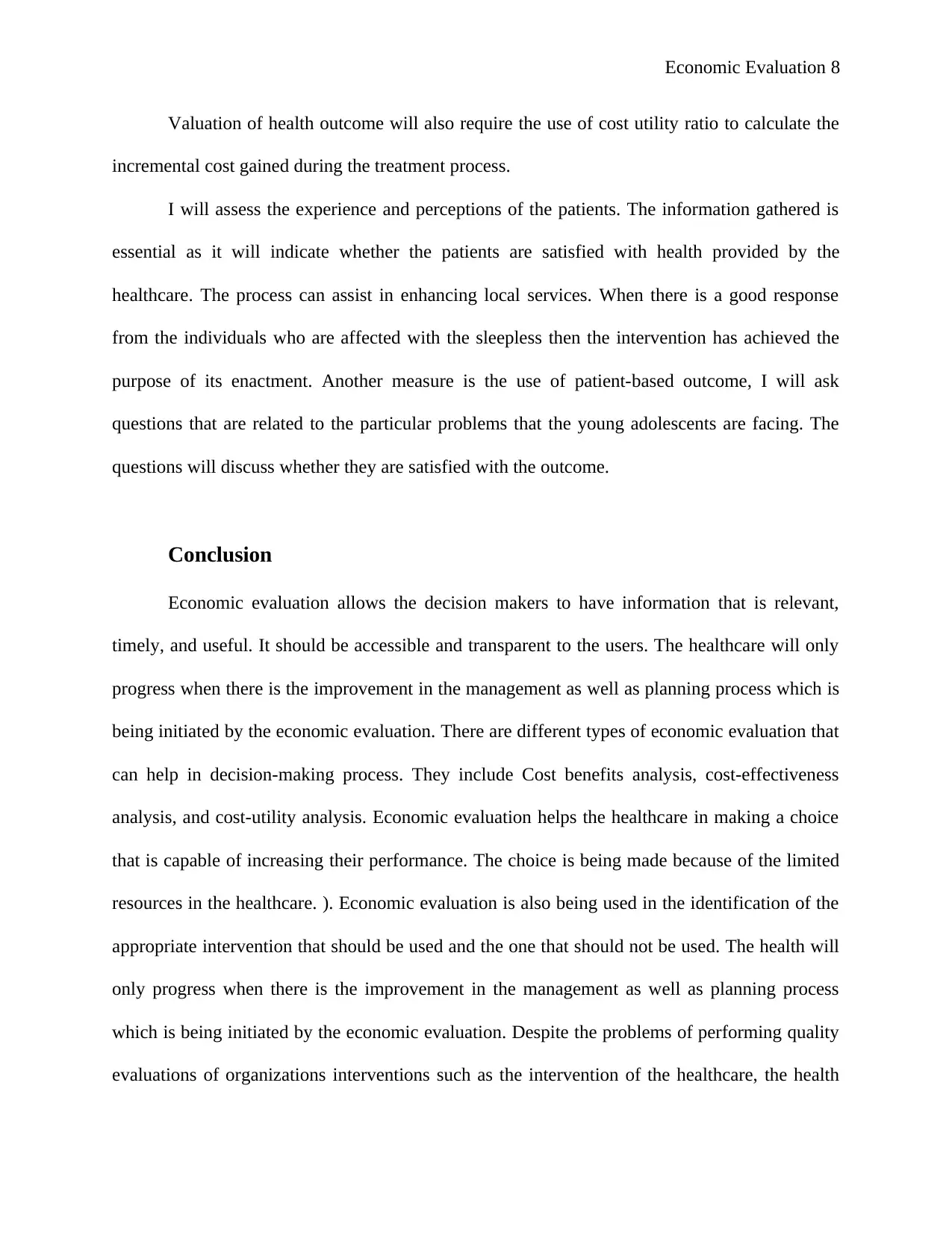
Economic Evaluation 8
Valuation of health outcome will also require the use of cost utility ratio to calculate the
incremental cost gained during the treatment process.
I will assess the experience and perceptions of the patients. The information gathered is
essential as it will indicate whether the patients are satisfied with health provided by the
healthcare. The process can assist in enhancing local services. When there is a good response
from the individuals who are affected with the sleepless then the intervention has achieved the
purpose of its enactment. Another measure is the use of patient-based outcome, I will ask
questions that are related to the particular problems that the young adolescents are facing. The
questions will discuss whether they are satisfied with the outcome.
Conclusion
Economic evaluation allows the decision makers to have information that is relevant,
timely, and useful. It should be accessible and transparent to the users. The healthcare will only
progress when there is the improvement in the management as well as planning process which is
being initiated by the economic evaluation. There are different types of economic evaluation that
can help in decision-making process. They include Cost benefits analysis, cost-effectiveness
analysis, and cost-utility analysis. Economic evaluation helps the healthcare in making a choice
that is capable of increasing their performance. The choice is being made because of the limited
resources in the healthcare. ). Economic evaluation is also being used in the identification of the
appropriate intervention that should be used and the one that should not be used. The health will
only progress when there is the improvement in the management as well as planning process
which is being initiated by the economic evaluation. Despite the problems of performing quality
evaluations of organizations interventions such as the intervention of the healthcare, the health
Valuation of health outcome will also require the use of cost utility ratio to calculate the
incremental cost gained during the treatment process.
I will assess the experience and perceptions of the patients. The information gathered is
essential as it will indicate whether the patients are satisfied with health provided by the
healthcare. The process can assist in enhancing local services. When there is a good response
from the individuals who are affected with the sleepless then the intervention has achieved the
purpose of its enactment. Another measure is the use of patient-based outcome, I will ask
questions that are related to the particular problems that the young adolescents are facing. The
questions will discuss whether they are satisfied with the outcome.
Conclusion
Economic evaluation allows the decision makers to have information that is relevant,
timely, and useful. It should be accessible and transparent to the users. The healthcare will only
progress when there is the improvement in the management as well as planning process which is
being initiated by the economic evaluation. There are different types of economic evaluation that
can help in decision-making process. They include Cost benefits analysis, cost-effectiveness
analysis, and cost-utility analysis. Economic evaluation helps the healthcare in making a choice
that is capable of increasing their performance. The choice is being made because of the limited
resources in the healthcare. ). Economic evaluation is also being used in the identification of the
appropriate intervention that should be used and the one that should not be used. The health will
only progress when there is the improvement in the management as well as planning process
which is being initiated by the economic evaluation. Despite the problems of performing quality
evaluations of organizations interventions such as the intervention of the healthcare, the health
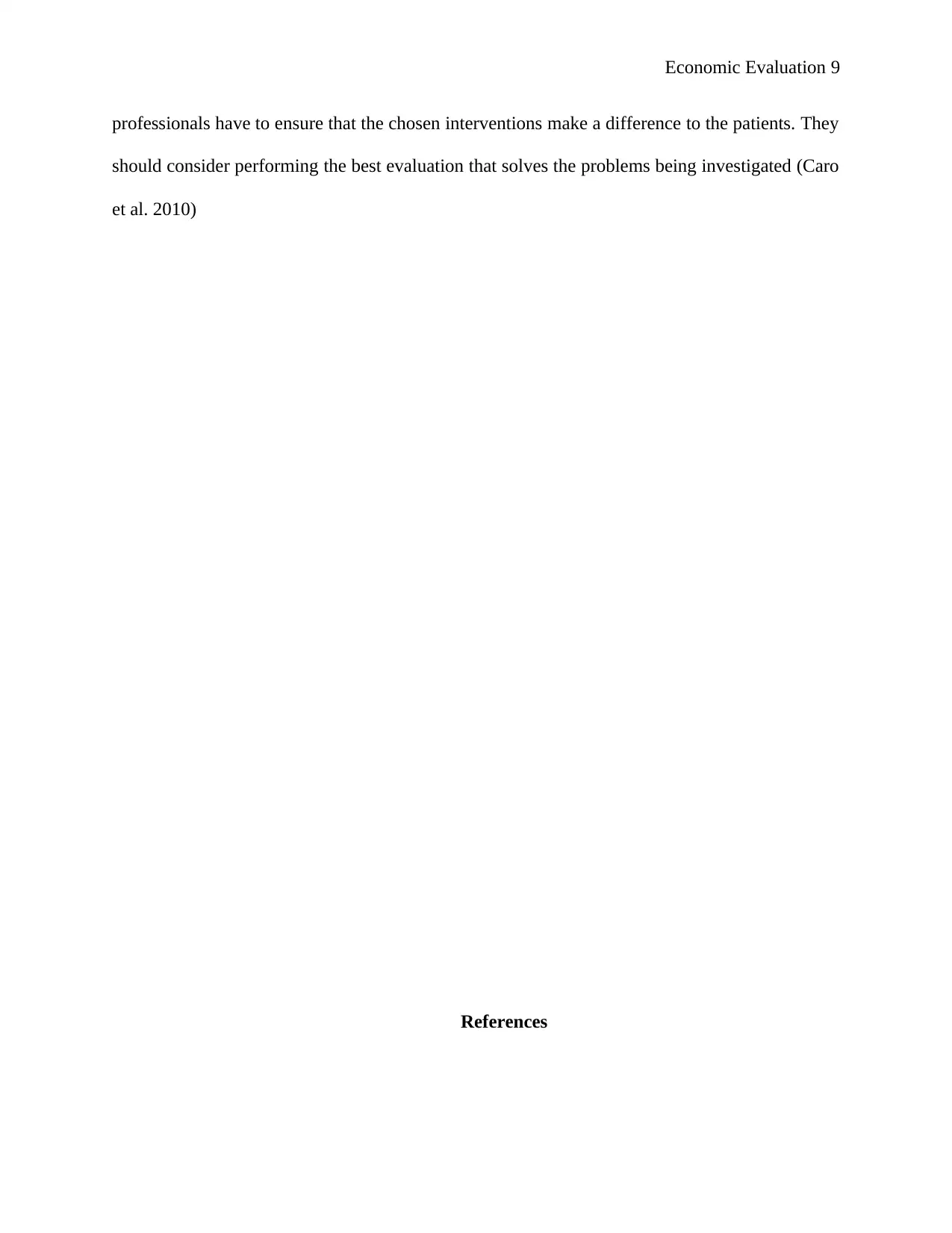
Economic Evaluation 9
professionals have to ensure that the chosen interventions make a difference to the patients. They
should consider performing the best evaluation that solves the problems being investigated (Caro
et al. 2010)
References
professionals have to ensure that the chosen interventions make a difference to the patients. They
should consider performing the best evaluation that solves the problems being investigated (Caro
et al. 2010)
References
⊘ This is a preview!⊘
Do you want full access?
Subscribe today to unlock all pages.

Trusted by 1+ million students worldwide
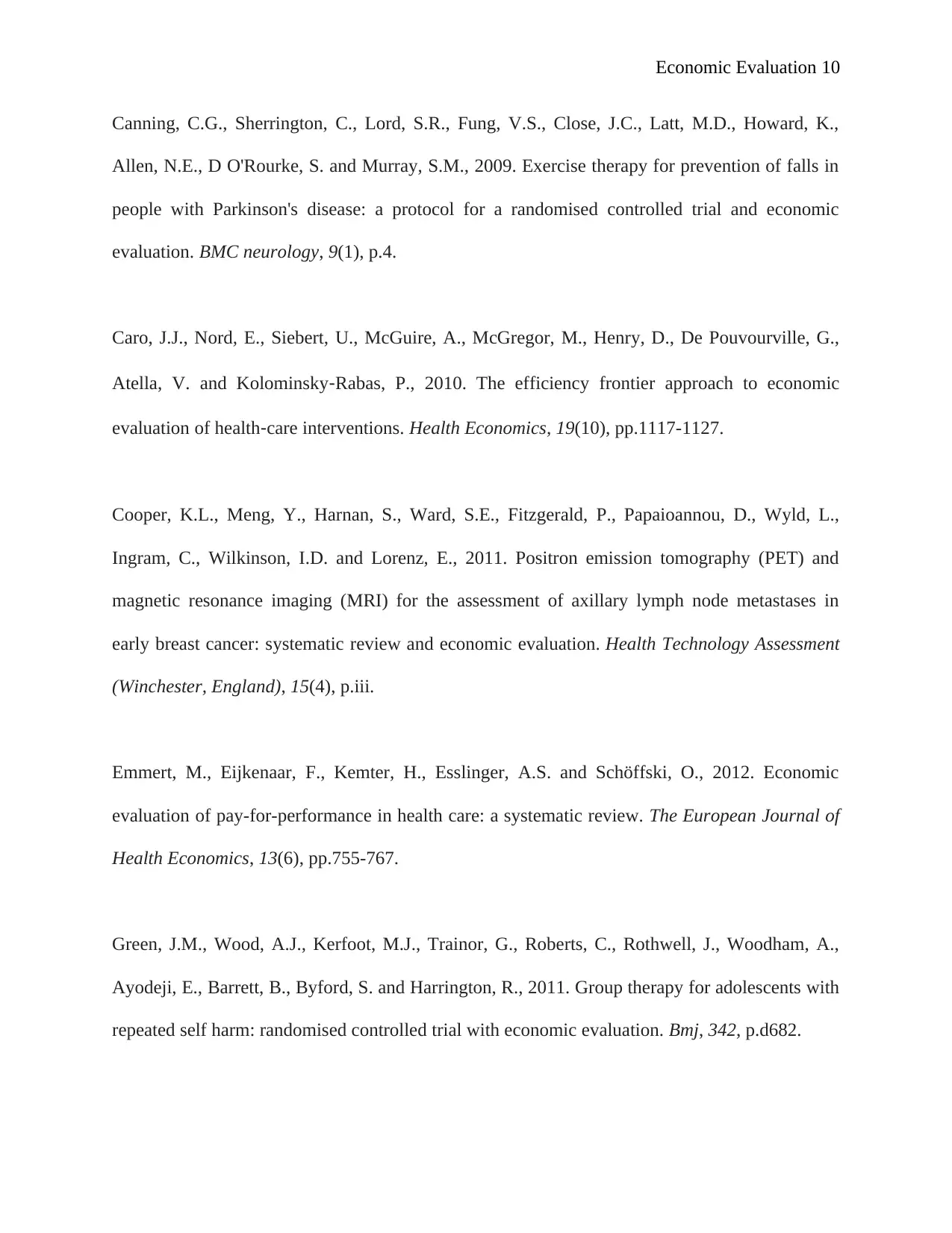
Economic Evaluation 10
Canning, C.G., Sherrington, C., Lord, S.R., Fung, V.S., Close, J.C., Latt, M.D., Howard, K.,
Allen, N.E., D O'Rourke, S. and Murray, S.M., 2009. Exercise therapy for prevention of falls in
people with Parkinson's disease: a protocol for a randomised controlled trial and economic
evaluation. BMC neurology, 9(1), p.4.
Caro, J.J., Nord, E., Siebert, U., McGuire, A., McGregor, M., Henry, D., De Pouvourville, G.,
Atella, V. and Kolominsky‐Rabas, P., 2010. The efficiency frontier approach to economic
evaluation of health‐care interventions. Health Economics, 19(10), pp.1117-1127.
Cooper, K.L., Meng, Y., Harnan, S., Ward, S.E., Fitzgerald, P., Papaioannou, D., Wyld, L.,
Ingram, C., Wilkinson, I.D. and Lorenz, E., 2011. Positron emission tomography (PET) and
magnetic resonance imaging (MRI) for the assessment of axillary lymph node metastases in
early breast cancer: systematic review and economic evaluation. Health Technology Assessment
(Winchester, England), 15(4), p.iii.
Emmert, M., Eijkenaar, F., Kemter, H., Esslinger, A.S. and Schöffski, O., 2012. Economic
evaluation of pay-for-performance in health care: a systematic review. The European Journal of
Health Economics, 13(6), pp.755-767.
Green, J.M., Wood, A.J., Kerfoot, M.J., Trainor, G., Roberts, C., Rothwell, J., Woodham, A.,
Ayodeji, E., Barrett, B., Byford, S. and Harrington, R., 2011. Group therapy for adolescents with
repeated self harm: randomised controlled trial with economic evaluation. Bmj, 342, p.d682.
Canning, C.G., Sherrington, C., Lord, S.R., Fung, V.S., Close, J.C., Latt, M.D., Howard, K.,
Allen, N.E., D O'Rourke, S. and Murray, S.M., 2009. Exercise therapy for prevention of falls in
people with Parkinson's disease: a protocol for a randomised controlled trial and economic
evaluation. BMC neurology, 9(1), p.4.
Caro, J.J., Nord, E., Siebert, U., McGuire, A., McGregor, M., Henry, D., De Pouvourville, G.,
Atella, V. and Kolominsky‐Rabas, P., 2010. The efficiency frontier approach to economic
evaluation of health‐care interventions. Health Economics, 19(10), pp.1117-1127.
Cooper, K.L., Meng, Y., Harnan, S., Ward, S.E., Fitzgerald, P., Papaioannou, D., Wyld, L.,
Ingram, C., Wilkinson, I.D. and Lorenz, E., 2011. Positron emission tomography (PET) and
magnetic resonance imaging (MRI) for the assessment of axillary lymph node metastases in
early breast cancer: systematic review and economic evaluation. Health Technology Assessment
(Winchester, England), 15(4), p.iii.
Emmert, M., Eijkenaar, F., Kemter, H., Esslinger, A.S. and Schöffski, O., 2012. Economic
evaluation of pay-for-performance in health care: a systematic review. The European Journal of
Health Economics, 13(6), pp.755-767.
Green, J.M., Wood, A.J., Kerfoot, M.J., Trainor, G., Roberts, C., Rothwell, J., Woodham, A.,
Ayodeji, E., Barrett, B., Byford, S. and Harrington, R., 2011. Group therapy for adolescents with
repeated self harm: randomised controlled trial with economic evaluation. Bmj, 342, p.d682.
Paraphrase This Document
Need a fresh take? Get an instant paraphrase of this document with our AI Paraphraser
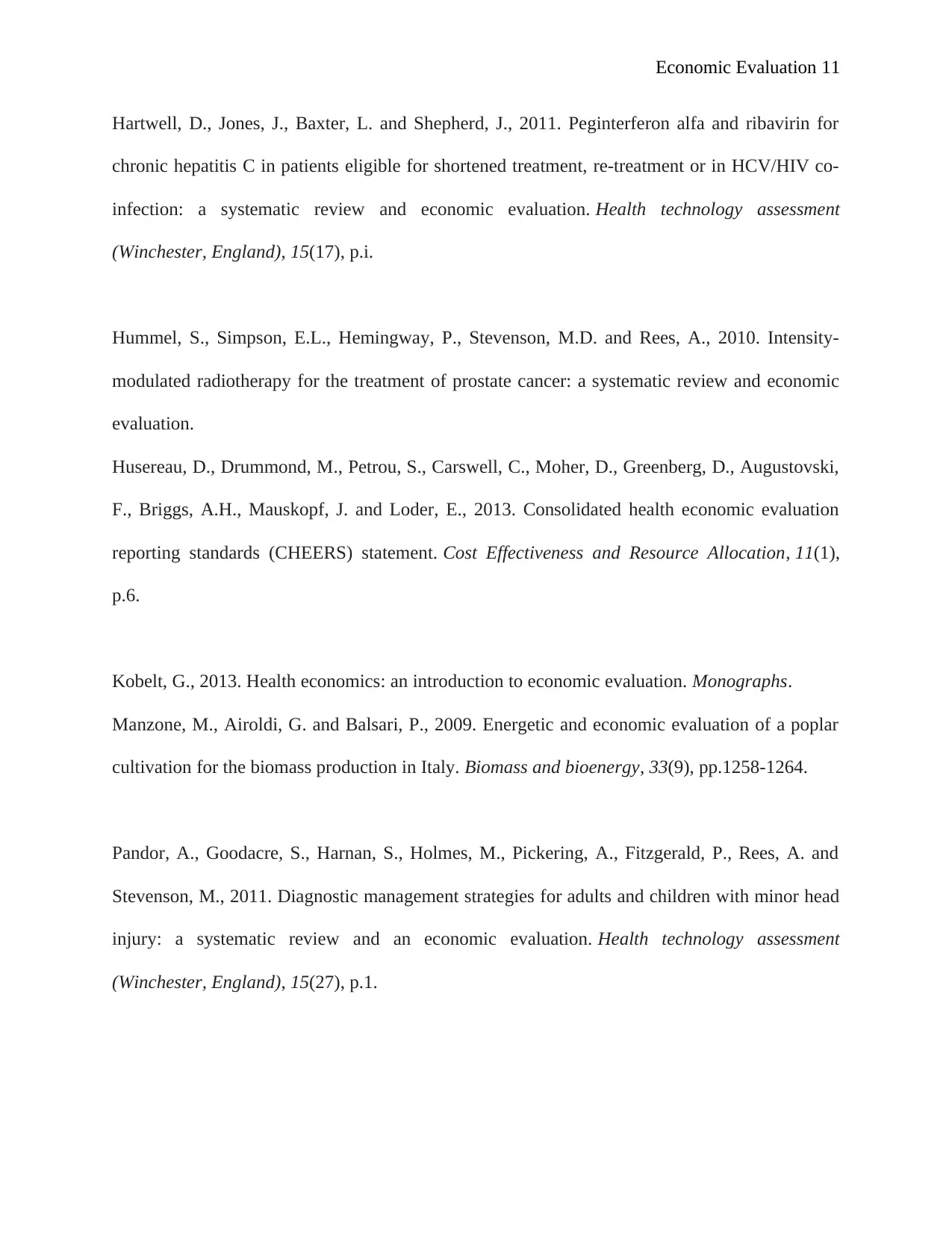
Economic Evaluation 11
Hartwell, D., Jones, J., Baxter, L. and Shepherd, J., 2011. Peginterferon alfa and ribavirin for
chronic hepatitis C in patients eligible for shortened treatment, re-treatment or in HCV/HIV co-
infection: a systematic review and economic evaluation. Health technology assessment
(Winchester, England), 15(17), p.i.
Hummel, S., Simpson, E.L., Hemingway, P., Stevenson, M.D. and Rees, A., 2010. Intensity-
modulated radiotherapy for the treatment of prostate cancer: a systematic review and economic
evaluation.
Husereau, D., Drummond, M., Petrou, S., Carswell, C., Moher, D., Greenberg, D., Augustovski,
F., Briggs, A.H., Mauskopf, J. and Loder, E., 2013. Consolidated health economic evaluation
reporting standards (CHEERS) statement. Cost Effectiveness and Resource Allocation, 11(1),
p.6.
Kobelt, G., 2013. Health economics: an introduction to economic evaluation. Monographs.
Manzone, M., Airoldi, G. and Balsari, P., 2009. Energetic and economic evaluation of a poplar
cultivation for the biomass production in Italy. Biomass and bioenergy, 33(9), pp.1258-1264.
Pandor, A., Goodacre, S., Harnan, S., Holmes, M., Pickering, A., Fitzgerald, P., Rees, A. and
Stevenson, M., 2011. Diagnostic management strategies for adults and children with minor head
injury: a systematic review and an economic evaluation. Health technology assessment
(Winchester, England), 15(27), p.1.
Hartwell, D., Jones, J., Baxter, L. and Shepherd, J., 2011. Peginterferon alfa and ribavirin for
chronic hepatitis C in patients eligible for shortened treatment, re-treatment or in HCV/HIV co-
infection: a systematic review and economic evaluation. Health technology assessment
(Winchester, England), 15(17), p.i.
Hummel, S., Simpson, E.L., Hemingway, P., Stevenson, M.D. and Rees, A., 2010. Intensity-
modulated radiotherapy for the treatment of prostate cancer: a systematic review and economic
evaluation.
Husereau, D., Drummond, M., Petrou, S., Carswell, C., Moher, D., Greenberg, D., Augustovski,
F., Briggs, A.H., Mauskopf, J. and Loder, E., 2013. Consolidated health economic evaluation
reporting standards (CHEERS) statement. Cost Effectiveness and Resource Allocation, 11(1),
p.6.
Kobelt, G., 2013. Health economics: an introduction to economic evaluation. Monographs.
Manzone, M., Airoldi, G. and Balsari, P., 2009. Energetic and economic evaluation of a poplar
cultivation for the biomass production in Italy. Biomass and bioenergy, 33(9), pp.1258-1264.
Pandor, A., Goodacre, S., Harnan, S., Holmes, M., Pickering, A., Fitzgerald, P., Rees, A. and
Stevenson, M., 2011. Diagnostic management strategies for adults and children with minor head
injury: a systematic review and an economic evaluation. Health technology assessment
(Winchester, England), 15(27), p.1.
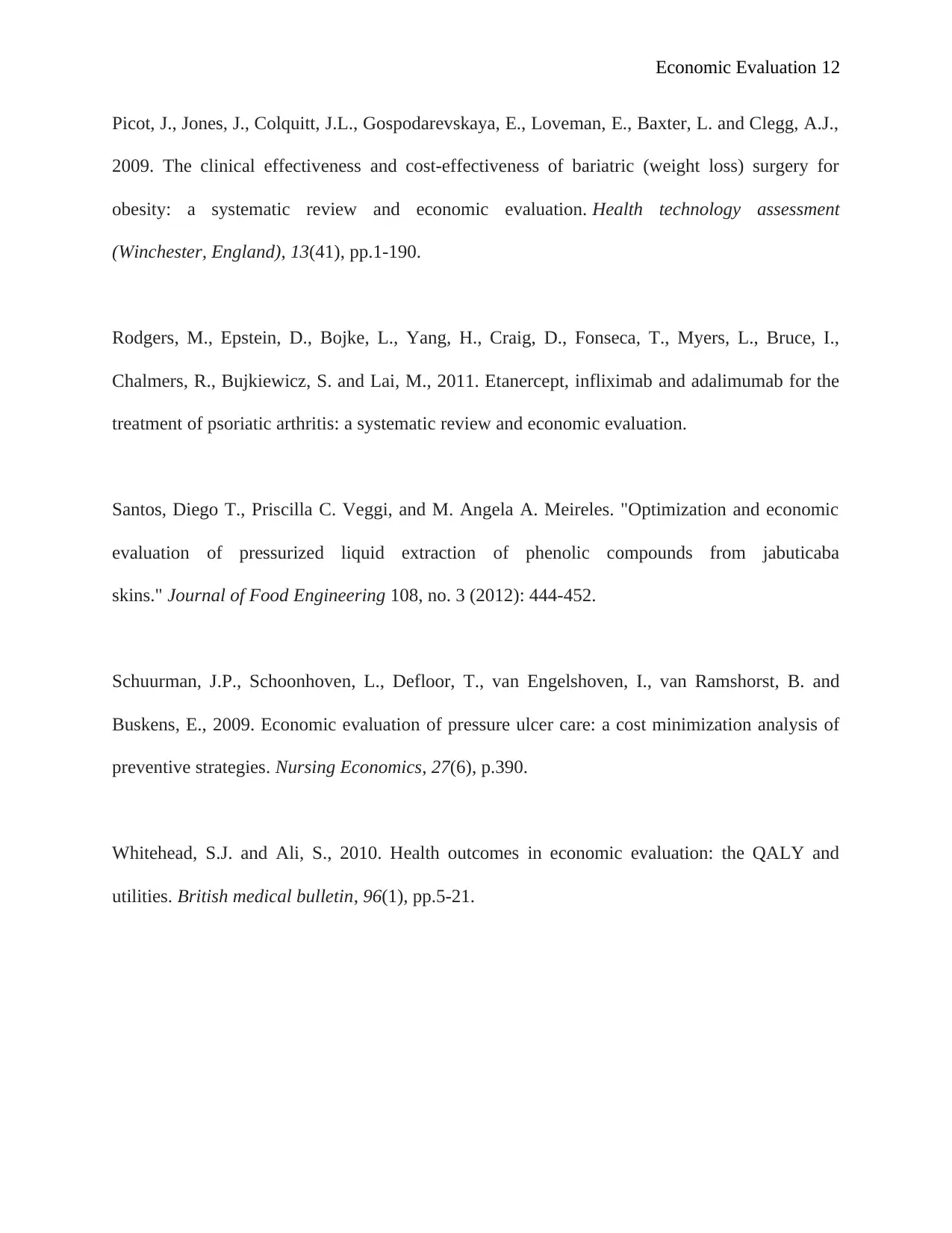
Economic Evaluation 12
Picot, J., Jones, J., Colquitt, J.L., Gospodarevskaya, E., Loveman, E., Baxter, L. and Clegg, A.J.,
2009. The clinical effectiveness and cost-effectiveness of bariatric (weight loss) surgery for
obesity: a systematic review and economic evaluation. Health technology assessment
(Winchester, England), 13(41), pp.1-190.
Rodgers, M., Epstein, D., Bojke, L., Yang, H., Craig, D., Fonseca, T., Myers, L., Bruce, I.,
Chalmers, R., Bujkiewicz, S. and Lai, M., 2011. Etanercept, infliximab and adalimumab for the
treatment of psoriatic arthritis: a systematic review and economic evaluation.
Santos, Diego T., Priscilla C. Veggi, and M. Angela A. Meireles. "Optimization and economic
evaluation of pressurized liquid extraction of phenolic compounds from jabuticaba
skins." Journal of Food Engineering 108, no. 3 (2012): 444-452.
Schuurman, J.P., Schoonhoven, L., Defloor, T., van Engelshoven, I., van Ramshorst, B. and
Buskens, E., 2009. Economic evaluation of pressure ulcer care: a cost minimization analysis of
preventive strategies. Nursing Economics, 27(6), p.390.
Whitehead, S.J. and Ali, S., 2010. Health outcomes in economic evaluation: the QALY and
utilities. British medical bulletin, 96(1), pp.5-21.
Picot, J., Jones, J., Colquitt, J.L., Gospodarevskaya, E., Loveman, E., Baxter, L. and Clegg, A.J.,
2009. The clinical effectiveness and cost-effectiveness of bariatric (weight loss) surgery for
obesity: a systematic review and economic evaluation. Health technology assessment
(Winchester, England), 13(41), pp.1-190.
Rodgers, M., Epstein, D., Bojke, L., Yang, H., Craig, D., Fonseca, T., Myers, L., Bruce, I.,
Chalmers, R., Bujkiewicz, S. and Lai, M., 2011. Etanercept, infliximab and adalimumab for the
treatment of psoriatic arthritis: a systematic review and economic evaluation.
Santos, Diego T., Priscilla C. Veggi, and M. Angela A. Meireles. "Optimization and economic
evaluation of pressurized liquid extraction of phenolic compounds from jabuticaba
skins." Journal of Food Engineering 108, no. 3 (2012): 444-452.
Schuurman, J.P., Schoonhoven, L., Defloor, T., van Engelshoven, I., van Ramshorst, B. and
Buskens, E., 2009. Economic evaluation of pressure ulcer care: a cost minimization analysis of
preventive strategies. Nursing Economics, 27(6), p.390.
Whitehead, S.J. and Ali, S., 2010. Health outcomes in economic evaluation: the QALY and
utilities. British medical bulletin, 96(1), pp.5-21.
⊘ This is a preview!⊘
Do you want full access?
Subscribe today to unlock all pages.

Trusted by 1+ million students worldwide
1 out of 13
Related Documents
Your All-in-One AI-Powered Toolkit for Academic Success.
+13062052269
info@desklib.com
Available 24*7 on WhatsApp / Email
![[object Object]](/_next/static/media/star-bottom.7253800d.svg)
Unlock your academic potential
Copyright © 2020–2025 A2Z Services. All Rights Reserved. Developed and managed by ZUCOL.





